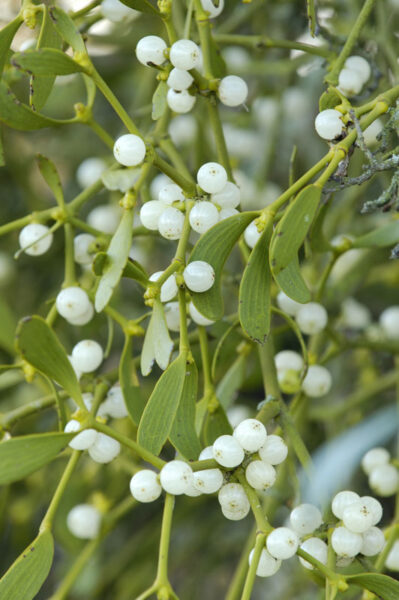Mistletoe (Viscum)

Mistletoe is a plant genus within the sandwood family. It lives as a semi-parasite on host trees, feeds on their water and minerals and appears as a spherical evergreen structure in the branches.
Myths and customs
Mistletoe is surrounded by various myths and customs. The best known is probably the kiss under the mistletoe at Christmas time. This is an English Christmas custom. During Advent, the mistletoe bears its ripe fruit: white, translucent berries. The custom says that if a boy and a girl meet under the mistletoe, they may kiss. However, one berry must be removed for each kiss. Conversely, this means that they were only allowed to kiss as often as there were berries on the mistletoe. The berries are therefore also called kissing balls. Germanic tribes, on the other hand, saw mistletoe as a lucky charm at the winter solstice, which is why they cut off branches. Christians seem to have adopted the tradition from one of these customs and decorated their homes with the evergreen branches at Christmas time. This trend was eventually replaced by the Christmas tree. But like so many trends, they are making a welcome return.
Mistletoe as a medicinal plant
Apart from legends, myths and customs, mistletoe is also known as a medicinal plant and has been used for over 2,300 years, including by Hippocrates. It was used to treat epilepsy, dizziness, cramps, splenomegaly and liver diseases. Rudolf Steiner, founder of anthroposophy, introduced mistletoe for the treatment of tumours, among other things. Initial studies scientifically demonstrated success in the treatment of animals with equine sarcoids, fibrosarcomas or mammary tumours. Miracles cannot be expected, but in the cases described, the quality of life of the animals was significantly improved, tumour growth slowed, recurrence reduced and in some cases, depending on the type of tumour, complete regression was achieved.
Mistletoe is also used in other preparations based on anthroposophical remedies, e.g. in Renes/Viscum comp. PlantaVet, a preparation used to treat renal insufficiency, which often occurs in older cats. The kidneys degenerate in this disease. This process can be halted by mistletoe. In addition, the vitalising mistletoe activates metabolic processes in the kidneys and stimulates urine formation.